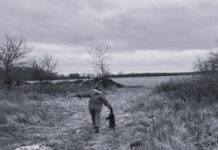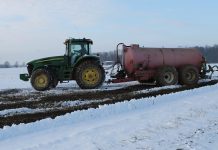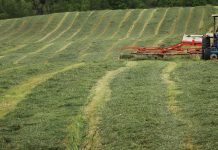Forty-five years may have dimmed a frame or two of memory but I can still see my father emptying small bags of flour-like powder into a five-gallon bucket and then slowing stirring in a trickle of water until the two ingredients combined to make a chalky, white cream.
The bags contained the still-new, pre-emergent herbicide atrazine. I also recall him sometimes stirring the creamy mix with a bare arm to ensure all the lumps of fine powder had dissolved fully.
Afterwards he’d just rinse off the white skim — in the bucket, of course: waste not — and continue on his weed-killing ways.
Changes
Today, no farmer can be found elbow deep into any container of pesticide, herbicide or fungicide. Back then, however, a decade before anyone ever heard the phrase “environmental protection agency,” agriculture was climbing the learning curve on how everyone was about to live better through chemistry.
And we did; a gazillion weeds never raised their nutrient-sucking heads in our corn fields. Dad killed ’em in their crib with help from Mr. Ciba and Mr. Geigy.
Fifty years on that’s still the case. Atrazine, according to 2005 USDA data (the latest) remains the most widely used farm herbicide in the nation. An estimated 76.4 million pounds was used that year; 86 percent in corn production.
Worldwide
But atrazine is bigger than America. Syngenta, Ciba’s successor, and competitors sell it in 80 nations.
Ironically, the European Union, Swiss-based Syngenta’s backyard, bans atrazine. The EU halted sales in 2004 over concerns linked to what it describes as atrazine’s persistent groundwater contamination.
Curiously, that ban came just a year after the U.S. EPA’s “Interim Reregistration Eligibility Decision” all but raised atrazine to sainthood here.
“The total or national economic impact resulting from the loss of atrazine,” noted EPA then, “would be in excess of $2 billion per year if atrazine were unavailable…” No doubt. But this and subsequent analyses didn’t — can’t — address new environmental concerns.
Water testing
Between 2003 and 2005, EPA surface and groundwater testing found 94 of 136 public water systems in 10 states contained atrazine at levels higher than EPA’s three parts per billion standard.
More recently, research by Tyrone Hayes, a professor of integrative biology at the University of California, indicates that atrazine concentrations 30-times less than EPA’s three ppb has caused dramatic changes in the reproduction systems of amphibians.
In lectures around the country, Hayes, a Harvard-trained biologist, notes that “a half million pounds of atrazine fall in rainwater every year in the U.S.” and that “1.2 million pounds flow into the Gulf of Mexico” annually.
Hayes’ research — and the physiological questions it raises — almost single-handedly brought atrazine back onto EPA’s radar.
Last October, EPA announced another detailed examination of atrazine to determine its “potential cancer and non-cancer effects on humans” and “its association with birth defects, low birth weight, and premature births.”
Backlash
In January, 53 farm groups rose to atrazine’s defense by claiming EPA was “politicizing” the review process by taking another look at atrazine. On May 3, the Wall Street Journal chimed in with a loud editorial that claimed the review will cause “(s)ome farmers to go out of business or ask the federal government for more subsidies.”
Does anyone anywhere seriously believe EPA would conduct a review of the most widely-used herbicide in global agriculture that wouldn’t be “transparent, peer-reviewed science,” as the farm groups demanded?
Does anyone honestly think the review itself will wipe out U.S. farmers? Good grief. If sound science is the goal, as the farm groups and Journal insist, then atrazine has nothing to hide in the review.
Until it’s completed, however, both need to get their arms out of the bucket.
(Alan Guebert’s Farm and Food File is published weekly in more than 75 newspapers in North America. He can be contacted at agcomm@sbcglobal.net.)
2010 ag comm














Mr. Guebert,
Really? Get our arms out of the bucket?
EPA acknowledges that activist pressure has led to this atrazine re-review. Their words, not mine. And for the record, atrazine is not banned in the EU as you say. I don’t mind the NRDC getting it wrong, but I expect a little more from a farm boy turned journalist like you.
EPA has already completed an exhaustive investigation into Hayes’ claims and studies. EPA published a 95-page white paper concluding that his study and other studies he cites are “scientifically flawed.” Hayes is not an unbiased scientist, he is an avowed anti-atrazine activist.
The fact is, it took a new political appointee at EPA (Assistant Administrator Steve Owens)to bow to the activist demands. It was not the career scientist that raised the new flag. After all, they had completed the process just three years ago.
I will keep my hands in the bucket for now, but might suggest others that claim to be supportive of agriculture, pull their head out of it.
Atrazine has been designated as and endocrine disruptor by the Endocrine Society of the United States due to it’s mechanistic perturbations. Dr. Tyrone Hayes research is one piece of the picture, beyond his research there are dozens of other labs from around the world who have performed outstanding research on atrazine. Result: atrazine affects the enzyme aromatase for estradiol production, as well as other mechanisms. These studies are all peer-reviewed in a variety of endocrine and toxicological journals. The EPA under President Bush shackled research and handed Syngenta a gift in allowing them to continue to sell atrazine in the US while it is not allowed to be sold in Europe. Potential long-term effects include increased prostate and breast cancers which are estrogen-responsive. Call your local official to have atrazine distribution revoked.